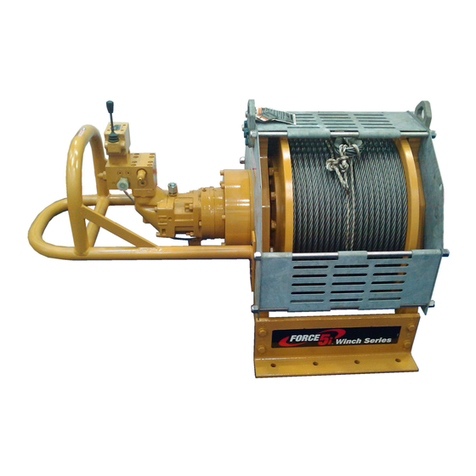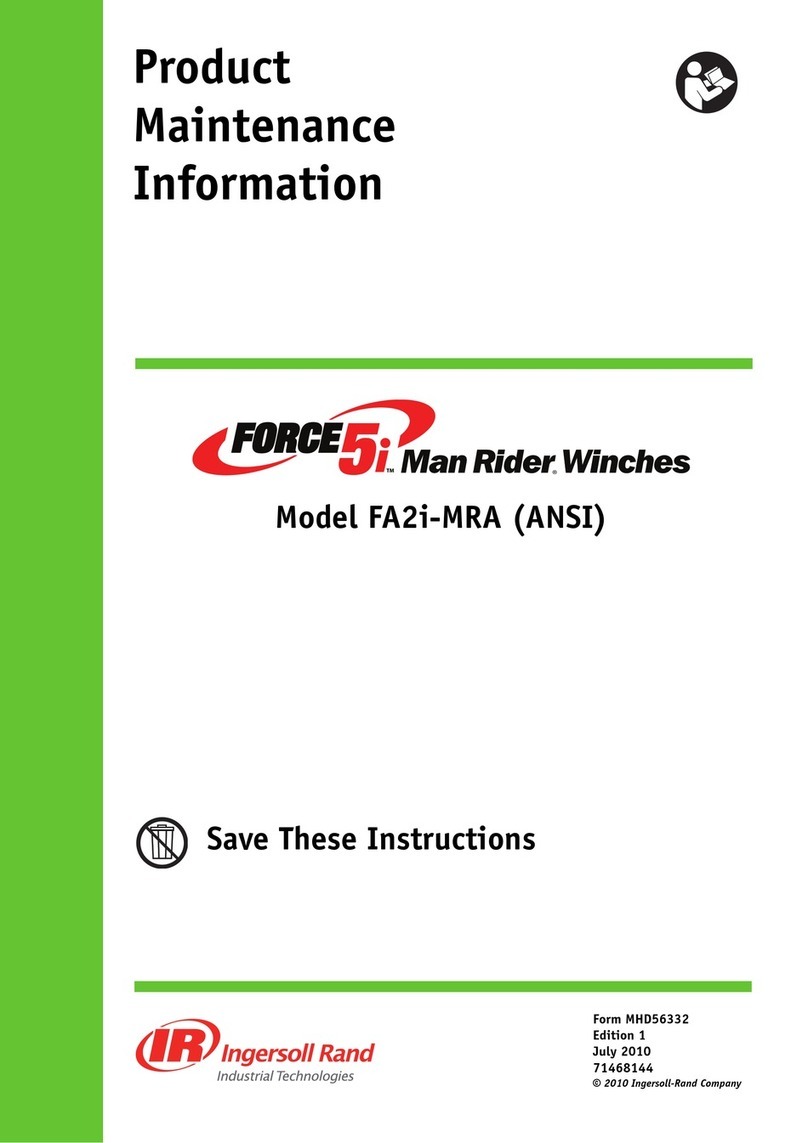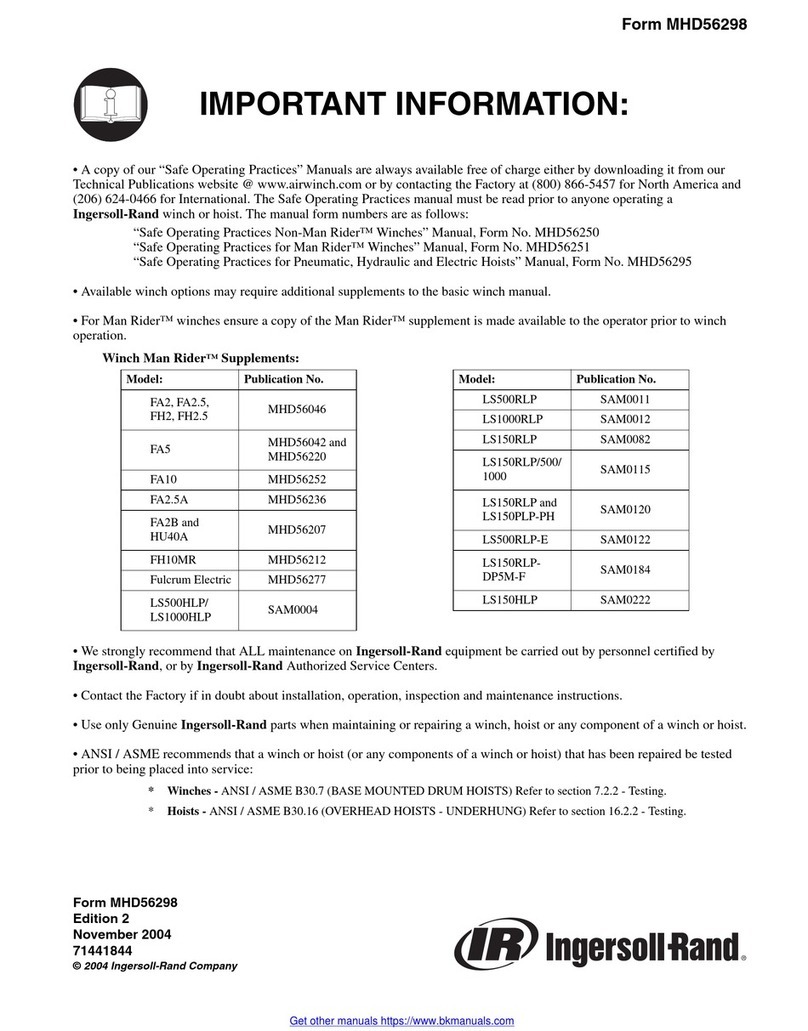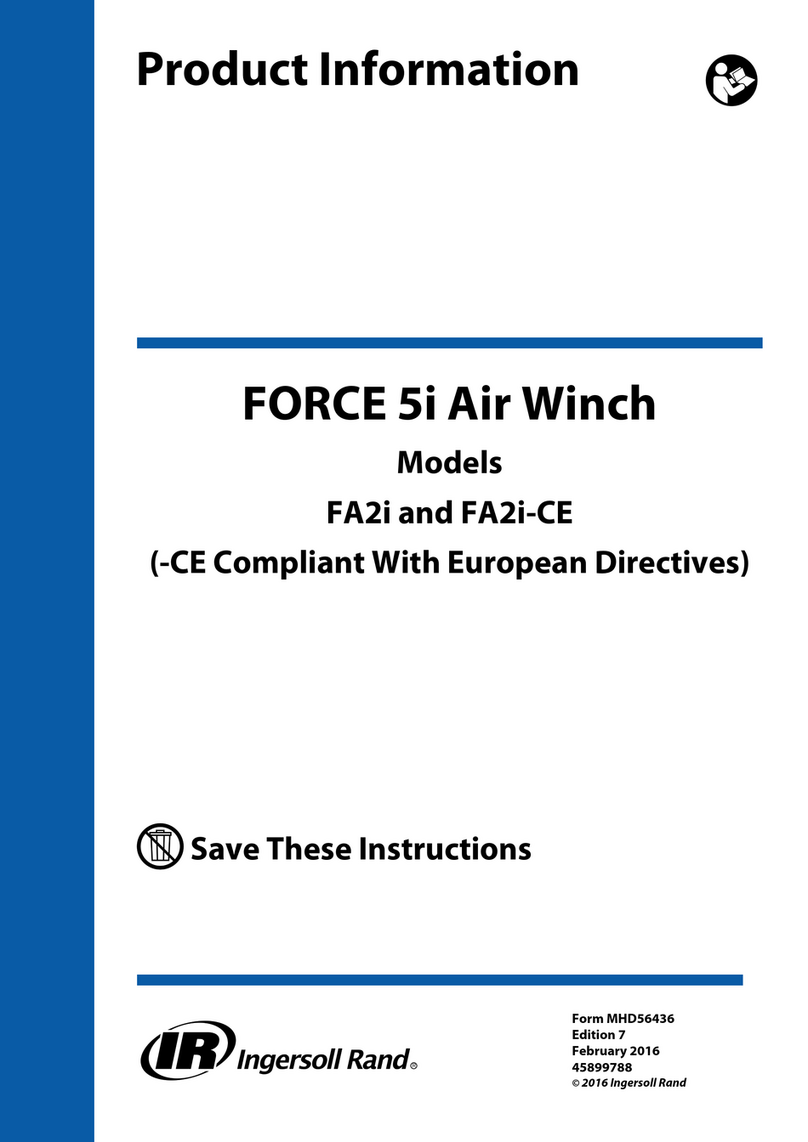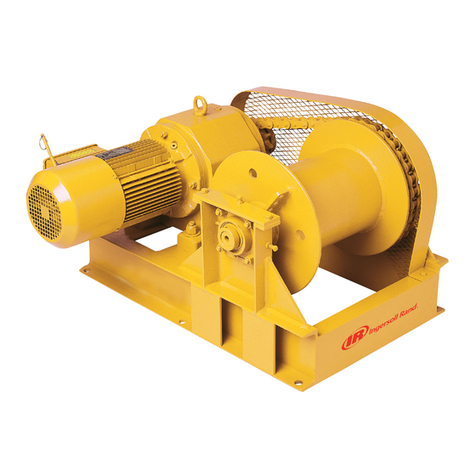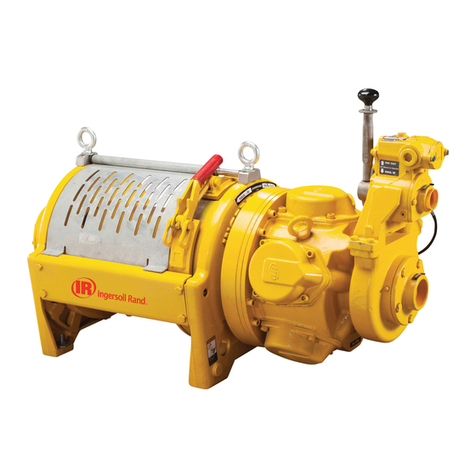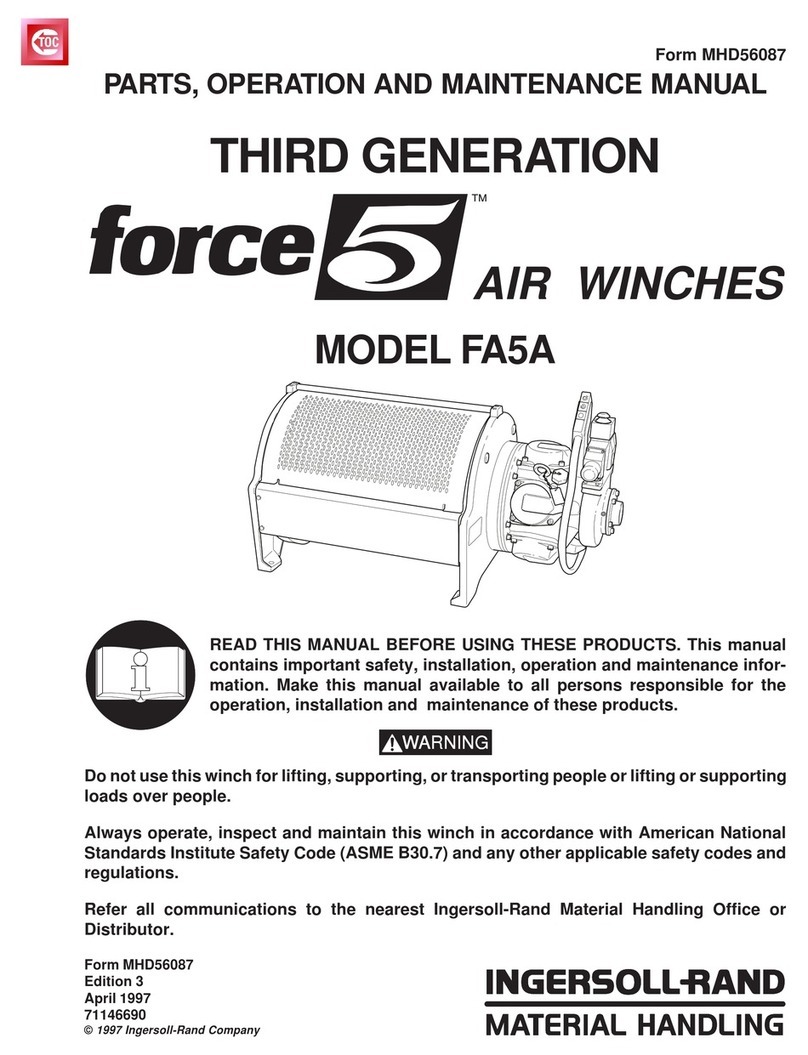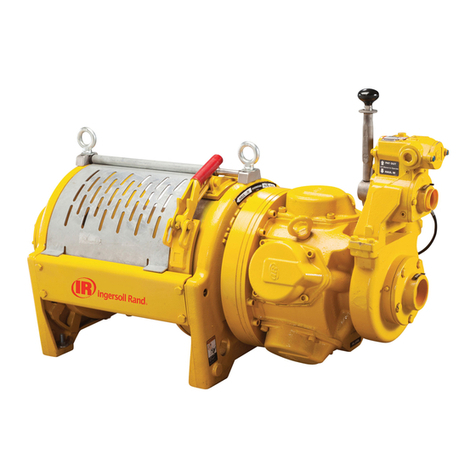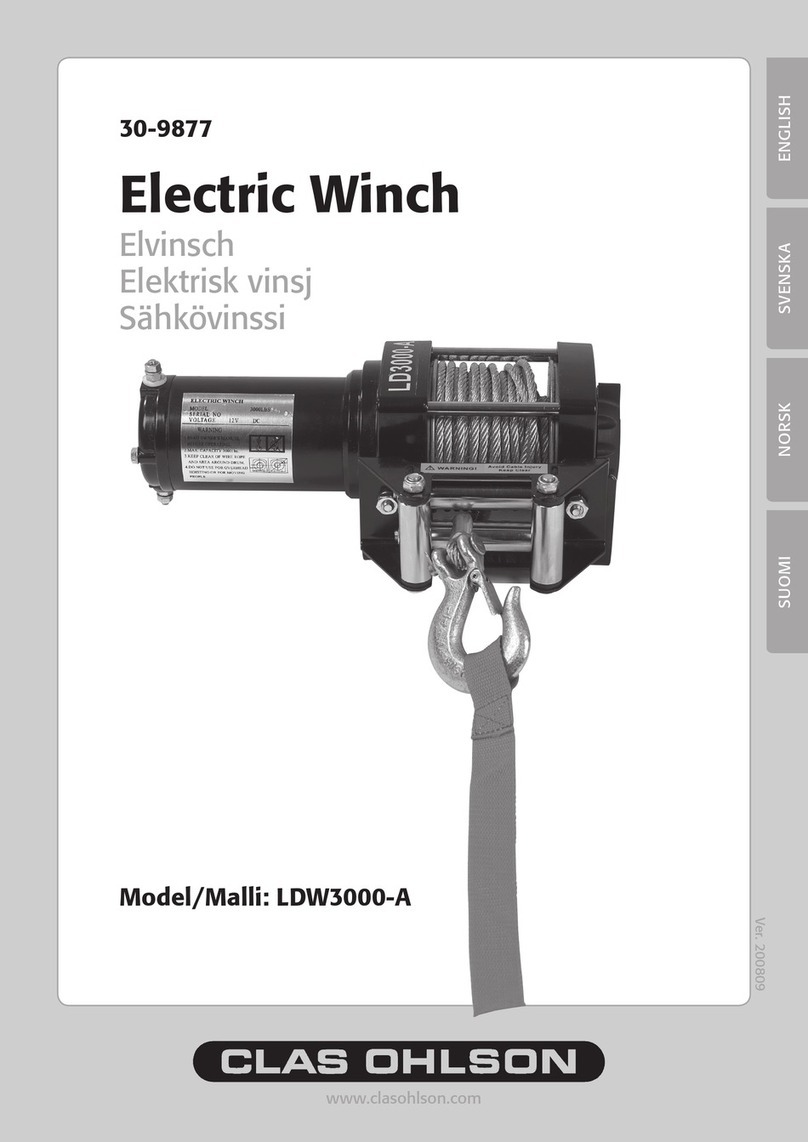
nNatural Gas Operation (optional feature)
WARNING
•Ensure all fittings and connections are tight. Inspect all connections with
suitable leak detection equipment.
•At first notice of any unusual odors or noticeable leaks, cease winch
operation until source is identified and corrected.
•Natural gas exhaust must be piped away from the winch.
The winch may be run using natural gas. However, motor and valve modifications are
required for this usage. Refer to Product Parts Information manual for additional
information. Use of natural gas will reduce motor life. Natural gas exhausting from
the winch must be piped away.
nInitial Winch Operating Checks
Winches are tested for proper operation prior to leaving the factory. Before the winch
is placed into service the following initial operating checks should be performed.
1. When first running the motor inject a small amount of light oil into the inlet
connection to provide initial lubrication.
2. Check oil level in motor and gear case grease are correct. Top off levels as required
before operation as described in “LUBRICATION” section on page 8.
3. Operate winch in both directions with no load for one to two minutes.
4. New brake band Lining Run-in Procedure: All new brake band linings require a
‘run-in’ period. Operate the winch without load in the payout direction while
gradually applying the brake. Allow the brake to slip for approximately one
minute. Winch motor may stall as drum brake band lining fully engages. Do not
allow brake to overheat.
5. Check operation of brakes. Adjust if necessary as described in “MAINTENANCE”
section in the Product Maintenance Information Manual.
6. Check operation of limit switches, locking mechanisms and all safety devices
when equipped.
7. Check foundation mounting fasteners are secure.
8. Install drum guard when provided.
For winches that have been in storage, the following start-up procedures are required:
1. Give the winch an inspection conforming to requirements of
‘Winches Not in Regular Use’ on page 7.
2. Pour a small amount of ISO VG 32 (SAE 10W) oil in motor inlet port.
3. Operate motor for 15 seconds in both directions to flush out any impurities.
4. The winch is now ready for normal use.
OPERATION
It is recommended that the user and owner check all appropriate and applicable
regulations before placing this product into use. Refer to Product Safety Information
Manual before operating product.
The four most important aspects of product operation are:
1. Follow all safety instructions when operating the product.
2. Allow only people trained in safety and operation of this winch to operate this
equipment.
3. Subject each product to a regular inspection and maintenance procedure.
4. Be aware of product capacity and weight of load at all times.
WARNING
• Do not lift loads over people.
NOTICE
• Refer to Product Parts Information Manual for drawings unless specified
elsewhere.
nWinch Controls
The spring loaded, motor mounted, live air manual throttle control valve is supplied
as a standard feature on this winch. Optional remote throttle controls are available.
Reference model code on the winch data (name) plate and compare it to
“SPECIFICATIONS” on page 3, to determine your configuration. The throttle controls
provide operator control of motor speed and direction of drum rotation.
nWinch Mounted Air Throttle (standard feature)
Refer to Dwg. MHP1239 on page 10, A. Haul-in; B. Payout.
The winch control throttle valve is spring loaded, full flow air and mounts to the
motor rotary housing.
To operate control valve, place palm of hand on control knob and wrap fingers around
flange of sliding handle. Squeeze fingers, lifting sliding handle up to unlock control
handle. Shift control handle in desired direction to payout or haul-in wire rope. As
viewed from air motor end, move control throttle handle to the right (clockwise) to
payout wire rope and to the left (counterclockwise) to haul-in wire rope. Avoid sudden
movements of handle to ensure smooth operation of winch. When released, handle
will return to neutral or center position, sliding handle will drop down to engage and
lock control handle in place.
nRemote Full Flow Air Pendant Throttle (optional feature)
Refer to Dwg. MHP1319 on page 10, A. Haul-in; B. Payout.
Provides for remote winch control at distances of up to 20 feet* (6 metres) away from
the winch. The pendant control throttle is a two lever movable control station for
winch operation. The winch control valve, located on the winch motor, controls the
motor speed and direction of drum rotation. Direction of rotation is determined by
the pendant lever depressed.
* For distances greater than 20 feet (6 metres) contact Technical Sales for control
acceptability.
nRemote Pilot Pendant Throttle (optional feature)
Refer to Dwg. MHP1546 on page 10.
Provides for remote winch control at distances of up to 66 feet* (20 metres) away
from winch. The pilot pendant control throttle is a two function movable control
station for winch operation. Pilot pressure from pendant control activates winch
control valve. The winch control valve, located on winch motor, controls motor speed
and direction of drum rotation. Direction of drum rotation is determined by the
pendant lever/button depressed.
* For distances greater than 66 feet (20 metres) contact Technical Sales for control
acceptability.
nWinch Brakes
nManual Drum Brake (standard)
The manual drum band brake may be applied by pushing down on handle and released
by pulling up. If handle is pushed down fully, it should lock in that position and
prevent drum rotation, until released by operator. The brake must be kept properly
adjusted to hold required load. Refer to ‘Adjustments’ in “MAINTENANCE” section in
Product Maintenance Information Manual for instructions.
nAutomatic Drum Band Brake (optional feature)
The automatic drum band brake is a spring applied, air released brake which utilizes
an air actuated, spring loaded cylinder, that automatically disengages brake when
motor is operated. Air pressure in cylinder overcomes spring pressure to release brake.
When control valve is placed in neutral position, air in cylinder is vented and spring
automatically engages brake to prevent drum rotation.
The cylinder clevis must be kept properly adjusted to hold required load.
NOTICE
•Extended exposure to corrosive atmospheres can cause the band brake lining
to adhere to the drum. It is recommended when winch is not in operation
and in a no load condition that the band brake be left in a released position.
For winches equipped with an automatic brake, always ensure that clutch jaw spacers
are installed.
nFree Spool Clutch
WARNING
• Do not engage clutch when motor is running or drum is spinning, as this
produces a severe strain on parts.
•Do not disengage clutch when winch is loaded. Be sure clutch is fully engaged
before operating winch.
A jaw type clutch connects the gearing and drum. The function of the clutch is to
disengage the wire rope drum from the motor so that the wire rope can be unwound
from the drum by hand without working against the gearing and the compression of
the motor. The clutch is engaged or disengaged by the clutch lever which is located
on the top of the gear case cover. When clutch is engaged the lever is locked by a
detent to prevent disengagement. Detent is released by pressing down (toward base)
on lever, after which the end can be swung outward from the winch, disengaging the
clutch jaws. When clutch is in disengaged position it can be engaged by moving end
of lever toward winch. It may be necessary to open the throttle a slight amount to
position the jaws for engagement.
WARNING
• Do not use free spool clutch feature in combination with automatic brake.
Use of winches with free spool clutch and automatic brake can result in
severe injury, death or property damage.
6 Form MHD56381 Edition 2
